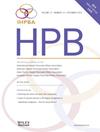Residency robotic biotissue curriculum: the next frontier in robotic surgical training
IF 2.4
3区 医学
Q2 GASTROENTEROLOGY & HEPATOLOGY
引用次数: 0
Abstract
Introduction
Virtual reality has been shown to be a strong introduction to the robot. However, we hypothesized that a biotissue curriculum including common surgical anastomoses can further enhance robotic technical skills in surgical residents.
Methods
Post-graduate-year three (PGY-3) general surgery residents completed a two-week robotic simulation rotation. The inanimate exercises used biotissue to simulate common robotic anastomoses, including the running hepaticojejunostomy (RHJ), gastrojejunostomy (GJ), interrupted hepaticojejunostomy (IHJ), and pancreaticojejunostomy (PJ). Drills were timed and graded according to modified Objective Structured Assessment of Technical Skills (OSATS; range 6–30).
Results
32 residents completed the curriculum. 81.3% of residents reported prior experience at the surgeon console (median=5 operations). Across all drills the average time to completion decreased from first to fourth attempt (RHJ: 33.7±8.9 vs. 26.3±8.1 min, p<0.001; GJ: 57.2±15.1 vs. 44.6±9.5 min, p<0.001; IHJ: 32.6±7.2 vs. 27.1±7.7 min, p<0.001; PJ: 44.2±9.3 vs. 35.6±10.5 min, p<0.001). Average OSATS score increased across all drills as well (RHJ: 16.0±3.8 vs. 23.3±3.4, p<0.001; GJ: 19.4±2.1 vs. 26.0±2.5, p<0.001; IHJ: 16.9±2.7 vs. 23.2±3.6, p<0.001, PJ: 17.9±2.6 vs. 23.6±3.6, p<0.001).
Conclusion
The robotic biotissue curriculum improves resident performance on robotic anastomoses. With the rise of the robotic platform, training in robotic procedures should be incorporated during surgical residency.
住院医师机器人生物组织课程:机器人外科训练的下一个前沿。
导论:虚拟现实已经被证明是机器人的有力介绍。然而,我们假设生物组织课程包括常见的外科吻合可以进一步提高外科住院医生的机器人技术技能。方法:研究生三年级(PGY-3)普外科住院医师完成了为期两周的机器人模拟轮转。无生命的练习使用生物组织模拟常见的机器人吻合术,包括运行型肝空肠吻合术(RHJ)、胃空肠吻合术(GJ)、中断型肝空肠吻合术(IHJ)和胰空肠吻合术(PJ)。根据修改后的技术技能目标结构化评估(OSATS;范围6-30)。结果:32名住院医师完成了课程。81.3%的住院医师报告有外科控制台的经验(中位数=5次手术)。在所有钻孔中,平均完成时间从第一次减少到第四次(RHJ: 33.7±8.9 vs. 26.3±8.1 min)。结论:机器人生物组织课程提高了机器人吻合术的住院医师表现。随着机器人平台的兴起,机器人程序的培训应纳入外科住院医师。
本文章由计算机程序翻译,如有差异,请以英文原文为准。
求助全文
约1分钟内获得全文
求助全文
来源期刊

Hpb
GASTROENTEROLOGY & HEPATOLOGY-SURGERY
CiteScore
5.60
自引率
3.40%
发文量
244
审稿时长
57 days
期刊介绍:
HPB is an international forum for clinical, scientific and educational communication.
Twelve issues a year bring the reader leading articles, expert reviews, original articles, images, editorials, and reader correspondence encompassing all aspects of benign and malignant hepatobiliary disease and its management. HPB features relevant aspects of clinical and translational research and practice.
Specific areas of interest include HPB diseases encountered globally by clinical practitioners in this specialist field of gastrointestinal surgery. The journal addresses the challenges faced in the management of cancer involving the liver, biliary system and pancreas. While surgical oncology represents a large part of HPB practice, submission of manuscripts relating to liver and pancreas transplantation, the treatment of benign conditions such as acute and chronic pancreatitis, and those relating to hepatobiliary infection and inflammation are also welcomed. There will be a focus on developing a multidisciplinary approach to diagnosis and treatment with endoscopic and laparoscopic approaches, radiological interventions and surgical techniques being strongly represented. HPB welcomes submission of manuscripts in all these areas and in scientific focused research that has clear clinical relevance to HPB surgical practice.
HPB aims to help its readers - surgeons, physicians, radiologists and basic scientists - to develop their knowledge and practice. HPB will be of interest to specialists involved in the management of hepatobiliary and pancreatic disease however will also inform those working in related fields.
Abstracted and Indexed in:
MEDLINE®
EMBASE
PubMed
Science Citation Index Expanded
Academic Search (EBSCO)
HPB is owned by the International Hepato-Pancreato-Biliary Association (IHPBA) and is also the official Journal of the American Hepato-Pancreato-Biliary Association (AHPBA), the Asian-Pacific Hepato Pancreatic Biliary Association (A-PHPBA) and the European-African Hepato-Pancreatic Biliary Association (E-AHPBA).
 求助内容:
求助内容: 应助结果提醒方式:
应助结果提醒方式:


